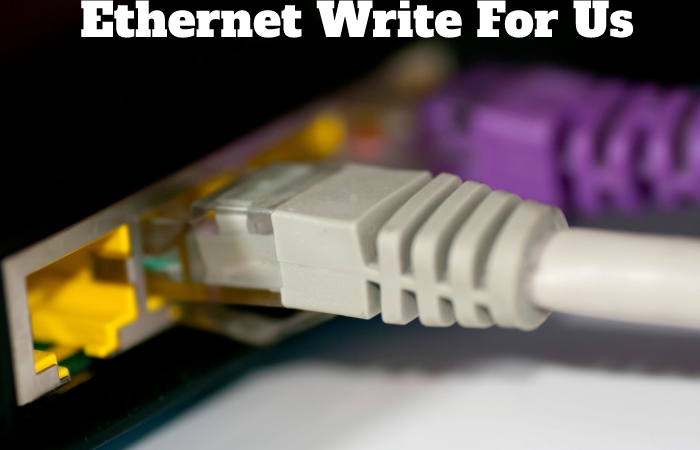
Ethernet Write For Us
Ethernet Write For Us – Technically dialogue, the Institute of Electrical and Electronics Engineers (IEEE) defines Ethernet as the 802.3 protocol. Of course, “Ethernet” is a much easier term, and you have probably seen it dozens of times all over the internet. To Write for Us, you can email us at contact@tipsfromcomputertechs.com
Particular). Aside from specific terminology, Ethernet refers to the most common type of local area network (LAN) used today. A LAN, in contrast to a WAN (Wide Area Network) that spans a larger geographic area, is a network of computers connected in a given area that is not very wide (such as an office, a university campus, or even a home). You may be reading this while connected to one.
What Ethernet is not at all is a wireless connection. In a world where Wi-Fi connectivity seems to be what defines our connected lives, you may be wondering: at this point, do or should modern laptops include an Ethernet port? Professional network power users and online gamers will answer you with a resounding “yes, of course; they should include it.” And we will explain why below.
How Ethernet Works
To send this data, it requires fragmenting it into tiny fractions, called ” Packet switching. “. ” This prevents the data from overlapping, each of these packets having specific information that will allow the package to know where it has to go, that is, which computers it has to access.
One of the main problems before the appearance of CSMA/CD was that sometimes several devices sent packets simultaneously, which caused a collision between the data that affected the transmission. However, thanks to this protocol, before sending the packages, the devices contact the network to find out if it is free to carry out the transmission so that, if so, send the data or, on the contrary, it will wait for it to be released to send it.
Ethernet: Speeds, Cables, and Installation
Because Ethernet has been around since the early 1970s, early speeds were only ten megabits per second (Mbps). Later, Fast Ethernet would arrive, which would raise those rates to 100 Mbps, and we currently have Gigabit Ethernet, which reaches 1,000 Mbps. Even if its use is limited to a handful of top technology companies this time, the new standard 10 Gigabit Ethernet (speeds of up to 10000 Mbps) is already on its way.
Being a wired connection protocol, the Ethernet cable you use is very relevant to its feat. Category 5 (or CAT5) is the most common type of Ethernet cable. This supports legacy and Fast Ethernet standards, while Category 5e and Category 6 (CAT5e and CAT6) cables can operate with Gigabit and 10 Gigabit Ethernet, respectively.
These cables connect your modem or modem router (gateway) to the Ethernet ports on your Internet-enabled devices, such as computers, laptops, or Smart TVs. If your device doesn’t have a built-in Ethernet port, you may need to use a USB to Ethernet adapter.
Advantages and Disadvantages
Advantage
- Relatively low cost
- compatibility with previous versions
- generally noise resistant
- good data transfer quality
- speed
- reliability
- data security: the usual firewalls can be used.
Disadvantages
- It is intended for smaller and shorter distance networks.
- Mobility is limited.
- Using longer cables can create crosstalk.
- It doesn’t work well with real-time or interactive applications.
- The increase in traffic causes the speed of the Ethernet to decrease.
- Receivers do not acknowledge receipt of data packets.
- When troubleshooting, it is difficult to determine which specific cable or node is causing the problem.
How to Submit Your Articles Ethernet Write For Us
To submit guest posts, please study through the guidelines mentioned below. You can contact us finished the website contact form or at contact@tipsfromcomputertechs.com
Why Write for Tips From Computer Techs – Ethernet Write For Us

- If you write to us, your business is targeted, and the consumer can read your article; you can have huge exposure.
- This will help in building relationships with your beleaguered audience.
- If you write for us, the obvious of your brand and contain worldly.
- Our presence is also on social media, and we share your article on social channels.
- You container link back to your website in the article, which stocks SEO value with your website.
Search Related Terms to Ethernet Write For Us
- Graphical user interface (GUI)
- User interface (UI)
- User experience (UX)
- Human-computer interaction (HCI)
- Information visualization
- Visual analytics
- Data visualization
- Interactive visualization
- Scientific visualization
- Information graphics
- Infographics
- Motion graphics
- Animation
- Augmented reality (AR)
- Virtual reality (VR)
- Mixed reality (MR)
- 3D user interfaces
- Touch user interfaces
- Voice user interfaces
- Gesture user interfaces
- Wearable user interfaces
- Ambient user interfaces
- Ubiquitous computing
Search Terms for Write For Us
- Digital Visual Interface Write for us
- Guest Post Digital Visual Interface
- Contribute Digital Visual Interface
- Digital Visual Interface Submit post
- Submit an article on Digital Visual Interface
- Become a guest blogger at Digital Visual Interface
- Digital Visual Interface writers wanted
- Suggest a post on Digital Visual Interface
- Digital Visual Interface guest author
Article Guidelines on Tips From Computer Techs – Digital Visual Interface Write For Us
- The author cannot be republished their guest post content on any other website.
- Your article or post should be unique, not copied or published anywhere on another website.
- The author cannot be republished their guest post content on any other website.
- You cannot add any affiliates code, advertisements, or referral links are not allowed to add into articles.
- High-quality articles will be published, and poor-quality papers will be rejected.
- An article must be more than 350 words.
- You can send your article to contact@tipsfromcomputertechs.com
